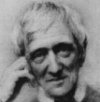
Principle 4. Literary FormsTo evaluate what the authors of Scripture want to affirm one has to take full account of the literary forms employed.
"Frequently the literal sense is not so obvious in the words and writings of ancient oriental authors as it is with the writers of today. For what they intended to signify by their writings is not determined only by the laws of grammar and philology nor merely by the context. It is absolutely necessary for the interpreter to go back in spirit to those remote centuries of the East and make proper use of the aids afforded by history, archaeology, ethnology and other sciences, in order to discover what literary forms the writers intended to use and did, de facto, employ." |
Interpreting Scripture CorrectlyLESSON FOUR
|
What are 'literary forms'?Let us examine an every example. Suppose you open a daily paper such as the Guardian . . .
Now reflect for a minute on your judgement on each of these statements. Without the least effort you have taken the Prince of Wales, treatment to be a fact. The article on tooth decay gave you matter for thought, even though you may have disagreed with some opinions expressed by the author. You did not for one minute believe the claim for Denty White toothpaste, and you certainly did not worry much about the fate of Tarzan's teeth. Reflect again: how did you so quickly evaluate each of these statements ? The answer is simple : automatically you had classified them under different categories: as anews item, aneditorial, anadvertisement and acomic strip. Having recognized them as such, you know what value to attribute to them. Literary forms are the categories - the frames of meaning - within which we speak or write. Contrary to what we might think superficially, the meaning of our words is not determined only by the dictionary. Consider the statement:
A vocabulary and an encylopedia will establish significations for each of the words. But we cannot as yet evaluate the true bearing of the statement unless we know in which category of writing, in which 'literary form', it occurs.
|
full of literary forms: news items
|
How do we know which literary form a statement belongs to?
Entering a bookshop we find an enormous variety of literary forms among the books. Again without any conscious effort, we recognize prayerbooks, grammars, technical manuals, anthologies of poetry, philosophical treatises, handbooks for school, collected essays, and many kinds of light reading! On what principle do we distinguish them so easily ? If we give some thought to the matter, we will find that we generally classify them on the strength of three characteristics : a. Because of their contents A handbook on cooking, a railway guide and a book of poetry do not leave us long in doubt as to what category they belong to! One glance at the contents and we know! b. Because of their style Comparing a prayerbook and a detective story novel, there is — apart from the contents — a marked difference in the style of the book. We instinctively recognize what kind of writing we are dealing with by the words used and by the style. c. Because of their 'setting-in-life!' Each literary form arose in a particular situation in life. Since we know our school system, the typical school manual immediately strikes us as something familiar. Since we ourselves sing in Church, a "hymn book" makes sense to us. In short we might define a literary form as a category of speaking or writing which (a) has its own kind of contents, which (b) employs a distinctive vocabulary and style, and which (c) is found in a particular situation in life. |
|
Unfamiliar literary formsAs long as we are dealing with our own literary forms, there is little need for such detailed analysis. We distinguish and select the various literary forms without even adverting to them, as little as we pay attention to the complicated mechanism of breathing. Breathing poses no problem as long as we have plenty of air. But for submarines and spacecraft that move out of the globe's belt of air, supplying the lungs with sufficient oxygen becomes a major issue that requires much research and constant vigilance. Much the same applies to people who move out of their surroundings into the intellectual world of others. Literary forms all of a sudden take on the greatest importance: from now on study and constant vigilance are required. If the Greek philosopher Plato were to have stepped into our country, he would have needed to adapt himself consciously to our literary forms. He would have needed a tutor to read the daily paper: "Don't take this advertisement too seriously,'"; "This story was merely put in for entertainment.'"; "Such letters to the Editor contain opinions of private people"; etc . After some time he would, no doubt, learn to distinguish our literary forms by studying the contents, vocabulary, style and situation-in-life of what is written or said. When approaching the Bible we should remember that we enter a world far removed from ours. Take, for instance, the psalms. To us they appear all as one category. The Jew recognized straight away a dozen different literary forms in them: hymns of praise, pilgrim songs, supplications of individuals or of the whole people, ballads for instruction, prayers of thanksgiving and so on. He could evaluate them immediately, just we recognize religious hymns, soldiers' songs, marches, or popular hits from pop culture. Because we lack direct experience of Jewish life and Jewish mentality, we have to learn to distinguish these kinds of psalms gradually. |
|
What about the Old Testament?The Old Testament is full of literary forms that are unfamiliar to us.
|
|
Case study: the parable of the lost sheepIn the Gospel of Luke we read the following parable:
In Matthew 18,12-14 we find the same parable but with a different lesson. How is that possible? To understand this fully we need to study the literary form of the parable in some depth. To begin with, see this video:
|
|
Exercise: the teaching on family relatonshipsIn the New Testament letters we find instructions on how to relate to members of one's family. For instance:
Try to work out for yourself the answers to the following questions:
|
|
Summing upThe meaning of any biblical statement can only be determined by a consideration of the literary form employed. God spoke through human authors. God spoke in their language. God framed his message in their mentality. God wanted to assert nothing more or less than what his human instruments wanted to assert. And what they wanted to assert can be defined with certainty only after a careful study of the literary forms they employed. The same dictionary is used by the novelist and the historian. But who would give the same interpretation to their works ? John Wijngaards |
|
|
Go to the next
lesson: Sacred Scripture knows all the shades of human affirmation. |
course overview |
CreditsThe texts in our course Interpreting Scripture Correctly were written by John Wijngaards in 2009. Part of the contents is based on his earlier publications, in particular:
Illustrations in the video clip by Jackie Clackson. |
 |
 |
 |
 |
 |
|
|---|---|---|---|---|---|
| Facts |
 |
 |
 |
 |
|||